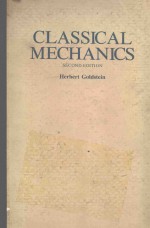图书介绍
CLASSICAL MECHANICSpdf电子书版本下载

- 著
- 出版社: ADDISON-WESLEY
- ISBN:0201029189
- 出版时间:1980
- 标注页数:672页
- 文件大小:71MB
- 文件页数:688页
- 主题词:
PDF下载
下载说明
CLASSICAL MECHANICSPDF格式电子书版下载
下载的文件为RAR压缩包。需要使用解压软件进行解压得到PDF格式图书。建议使用BT下载工具Free Download Manager进行下载,简称FDM(免费,没有广告,支持多平台)。本站资源全部打包为BT种子。所以需要使用专业的BT下载软件进行下载。如 BitComet qBittorrent uTorrent等BT下载工具。迅雷目前由于本站不是热门资源。不推荐使用!后期资源热门了。安装了迅雷也可以迅雷进行下载!
(文件页数 要大于 标注页数,上中下等多册电子书除外)
注意:本站所有压缩包均有解压码: 点击下载压缩包解压工具
图书目录
CHAPTER 1 SURVEY OF THE ELEMENTARY PRINCIPLES 1
1-1 Mechanics of a particle 1
1-2 Mechanics of a system of particles 5
1-3 Constraints 11
1-4 D’Alembert’s principle and Lagrange’s equations 17
1-5 Velocity-dependent potentials and the dissipation function 21
1-6 Simple applications of the Lagrangian formulation 25
CHAPTER 2 VARIATIONAL PRINCIPLES AND LAGRANGE’S EQUATIONS 35
2-1 Hamilton’s principle 35
2-2 Some techniques of the calculus of variations 37
2-3 Derivation of Lagrange’s equations from Hamilton’s principle 43
2-4 Extension of Hamilton’s principle to nonholonomic systems 45
2-5 Advantages of a variational principle formulation 51
2-6 Conservation theorems and symmetry properties 54
CHAPTER 3 THE TWO-BODY CENTRAL FORCE PROBLEM 70
3-1 Reduction to the equivalent one-body problem 70
3-2 The equations of motion and first integrals 71
3-3 The equivalent one-dimensional problem,and classification of orbits 77
3-4 The virial theorem 82
3-5 The differential equation for the orbit,and integrable power-law potentials 85
3-6 Conditions for closed orbits (Bertrand’s theorem) 90
3-7 The Kepler problem:Inverse square law of force 94
3-8 The motion in time in the Kepler problem 98
3-9 The Laplace-Runge-Lenz vector 102
3-10 Scattering in a central force field 105
3-11 Transformation of the scattering problem to laboratory coordinates 114
CHAPTER 4 THE KINEMATICS OF RIGID BODY MOTION 128
4-1 The independent coordinates of a rigid body 128
4-2 Orthogonal transformations 132
4-3 Formal properties of the transformation matrix 137
4-4 The Euler angles 143
4-5 The Cayley-Klein parameters and related quantities 148
4-6 Euler’s theorem on the motion of a rigid body 158
4-7 Finite rotations 164
4-8 Infinitesimal rotations 166
4-9 Rate of change of a vector 174
4-10 The Coriolis force 177
CHAPTER 5 THE RIGID BODY EQUATIONS OF MOTION 188
5-1 Angular momentum and kinetic energy of motion about a point 188
5-2 Tensors and dyadics 192
5-3 The inertia tensor and the moment of inertia 195
5-4 The eigenvalues of the inertia tensor and the principal axis transformation 198
5-5 Methods of solving rigid body problems and the Euler equations of motion 203
5-6 Torque-free motion of a rigid body 205
5-7 The heavy symmetrical top with one point fixed 213
5-8 Precession of the equinoxes and of satellite orbits 225
5-9 Precession of systems of charges in a magnetic field 232
CHAPTER 6 SMALL OSCILLATIONS 243
6-1 Formulation of the problem 243
6-2 The eigenvalue of equation and the principal axis transformation 246
6-3 Frequencies of free vibration,and normal coordinates 253
6-4 Free vibrations of a linear triatomic molecule 258
6-5 Forced vibrations and the effect of dissipative forces 263
CHAPTER 7 SPECIAL RELATIVITY IN CLASSICAL MECHANICS 275
7-1 The basic program of special relativity 275
7-2 The Lorentz transformation 278
7-3 Lorentz transformations in real four dimensional spaces 288
7-4 Further descriptions of the Lorentz transformation 293
7-5 Covariant four-dimensional formulations 298
7-6 The force and energy equations in relativistic mechanics 303
7-7 Relativistic kinematics of collisions and many-particle systems 309
7-8 The Lagrangian formulation of relativistic mechanics 320
7-9 Covariant Lagrangian formulations 326
CHAPTER 8 THE HAMILTON EQUATIONS OF MOTION 339
8-1 Legendre transformations and the Hamilton equations of motion 339
8-2 Cyclic coordinates and conservation theorems 347
8-3 Routh’s procedure and oscillations about steady motion 351
8-4 The Hamiltonian formulation of relativistic mechanics 356
8-5 Derivation of Hamilton’s equations from a variational principle 362
8-6 The principle of least action 365
CHAPTER 9 CANONICAL TRANSFORMATIONS 378
9-1 The equations of canonical transformation 378
9-2 Examples of canonical transformations 386
9-3 The symplectic approach to canonical transformations 391
9-4 Poisson brackets and other canonical invariants 397
9-5 Equations of motion,infinitesimal canonical transformations,and conservations theorems in the Poisson bracket formulation 405
9-6 The angular momentum Poisson bracket relations 416
9-7 Symmetry groups of mechanical systems 420
9-8 Liouville’stheorem 426
CHAPTER 10 HAMILTON-JACOBI THEORY 438
10-1 The Hamilton-Jacobi equation for Hamilton’s principal function 438
10-2 The harmonic oscillator problem as an example of the Hamilton-Jacobi method 442
10-3 The Hamilton-Jacobi equation for Hamilton’s characteristic function 445
10-4 Separation of variables in the Hamilton-Jacobi equation 449
10-5 Action-angle variables in systems of one degree of freedom 457
10-6 Action-angle variables for completely separable systems 463
10-7 The Kepler problem in action-angle variables 472
10-8 Hamilton-Jacobi theory,geometrical optics,and wave mechanics 484
CHAPTER 11 CANONICAL PERTURBATION THEORY 499
11-1 Introduction 499
11-2 Time-dependent perturbation (variation of constants) 500
11-3 Illustrations of time-dependent perturbation theory 506
11-4 Time-independent perturbation theory in first order with one degree of freedom 515
11-5 Time-independent perturbation theory to higher order 519
11-6 Specialized perturbation techniques in celestial and space mechanics 527
11-7 Adiabatic invariants 531
CHAPTER 12 INTRODUCTION TO THE LAGRANGIAN AND HAMILTONIAN FORMULATIONS FOR CONTINUOUS SYSTEMS AND FIELDS 545
12-1 The transition from a discrete to a continuous system 545
12-2 The Lagrangian formulation for continuous systems 548
12-3 The stress-energy tensor and conservation theorems 555
12-4 Hamiltonian formulation,Poisson brackets and the momentum representation 562
12-5 Relativistic field theory 570
12-6 Examples of relativistic field theories 575
12-7 Noetner’s theorem 588
APPENDIXES 601
A Proof of Bertrand’s Theorem 601
B Euler Angles in Alternate Conventions 606
C Transformatio?Properties of dΩ 611
D The Staeckel Conditions for Separability of the Hamilton-Jacobi Equation 613
E Lagrangian Formulation of the Acoustic Field in Gases 616
BIBLIOGRAPHY 621
INDEX OF SYMBQLS 631
INDEX 643
精品推荐
- Northanger Abbey(1818)
- Emma(1815)
- Sense And Sensibility(1811)
- Mansfield Park(1814)
- HUMANITIES THE EVOLUTION OF VALUES
- Pride And Drejudice(1812)
- English
- 企鹅经济学词典 经济学
- 大人的友情 河合隼雄谈友谊
- Computing Concepts
- Advanced Compilpr Design and lmplementation
- 中国商事法律要览
- Introduction to polymers
- CONFICT OF LAWS IN THE WESTERN SOCIALIST AND DEVELOPING COUNTRIES
- Measurement and Research Methods in International Marketing